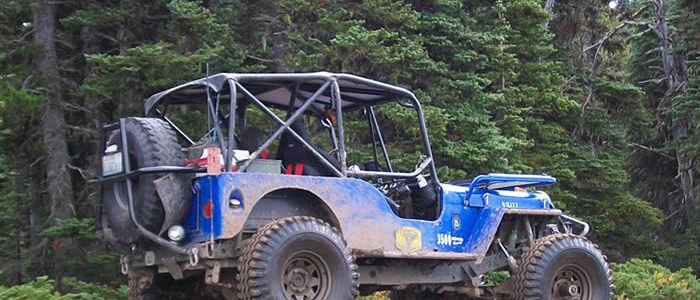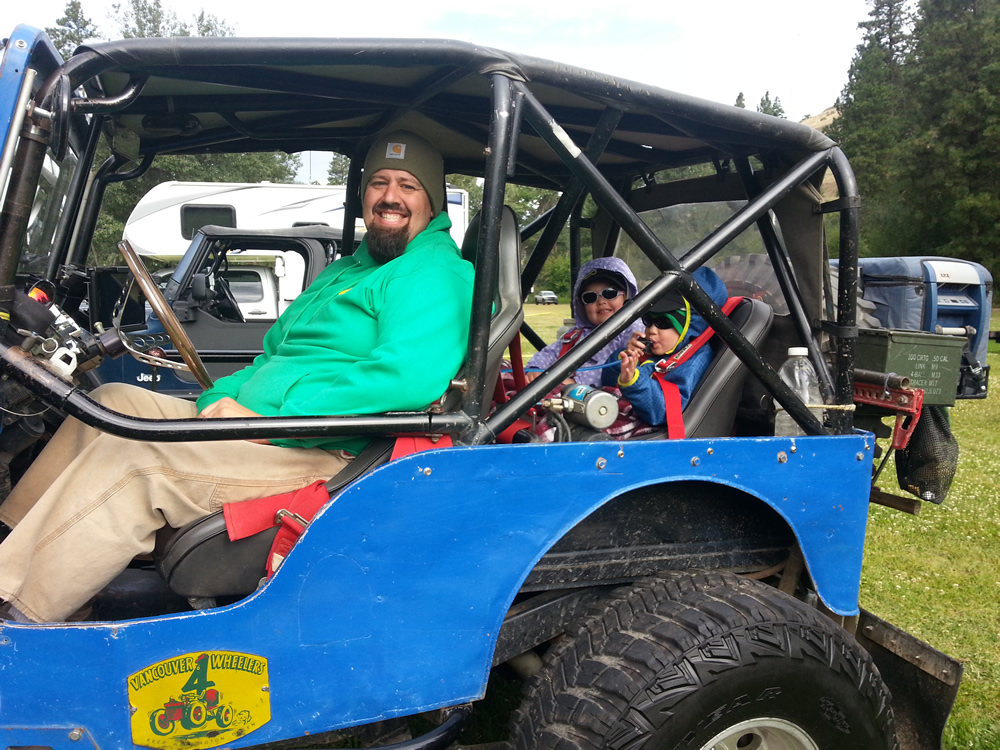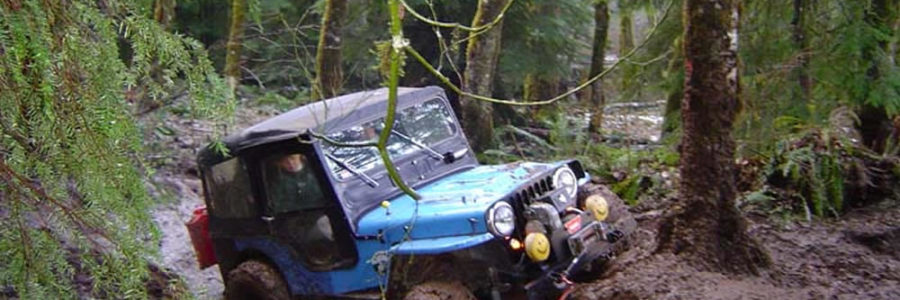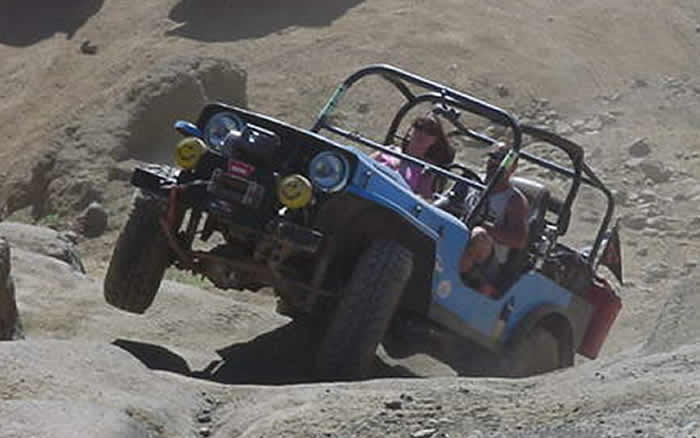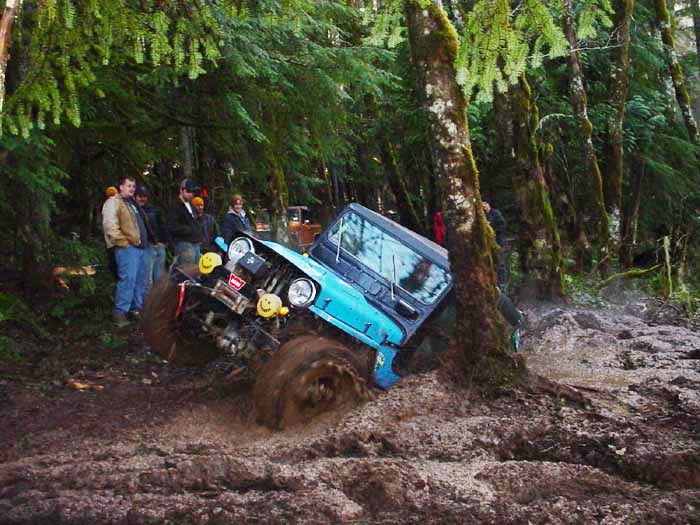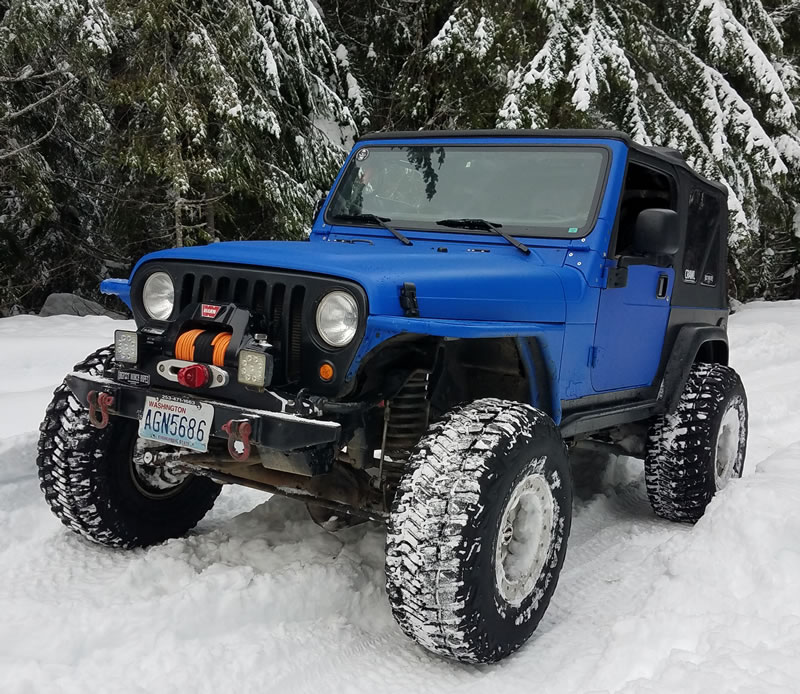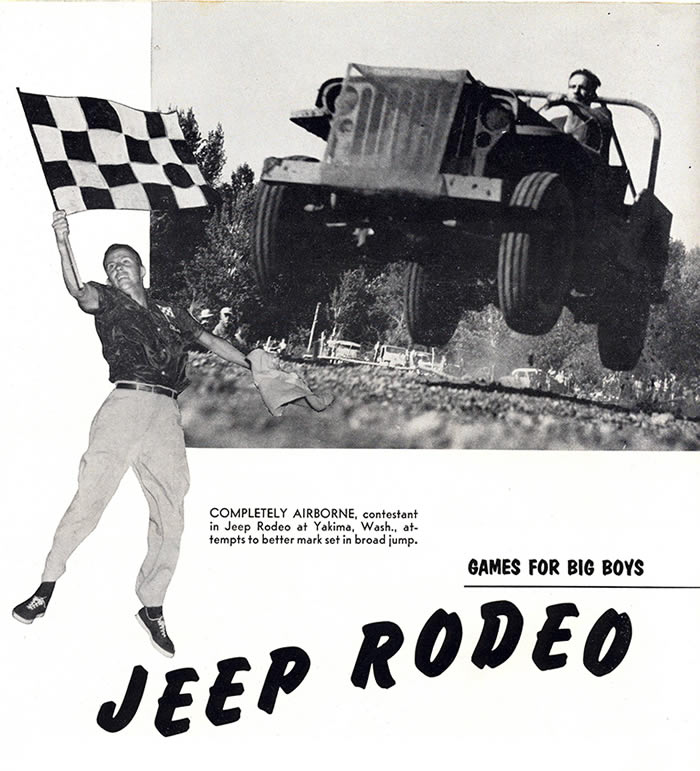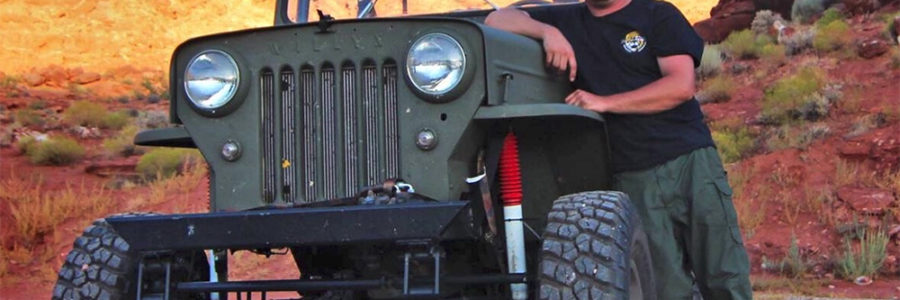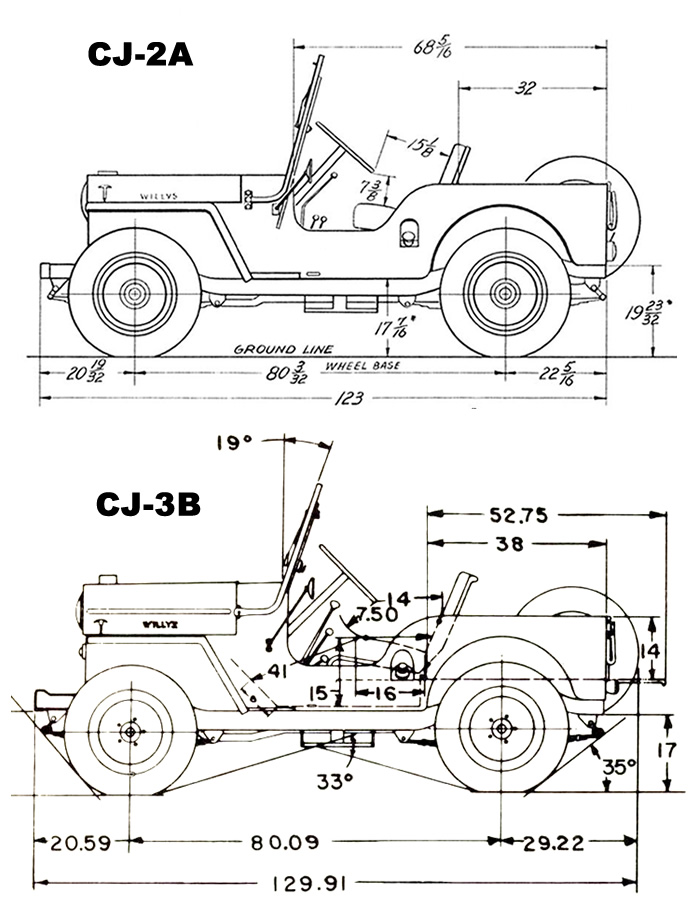
Marty Tilford and His Custom Flatfender
Mary Tilford will be driving his modified 1946 CJ-2A to Alaska with his friend, Don Brown.
Forty-year-old Marty Tilford’s wife Suzanna had no idea what was in store for her when she began dating her future husband. Marty had grown up a member of the Vancouver 4 Wheelers, one of the Pacific Northwest’s oldest four wheel drive clubs. To him, spending weekends exploring the Cascade Mountains, racing jeeps with fellow enthusiasts, and volunteering to make his surrounding community a better place, such as cleaning up ocean beaches every Fall, was just second nature. But, Suzanna’s first reaction to his jeep hobby was disbelief, “There’s a whole community built around jeeps?”
Fast forward twelve years and Suzanna’s disbelief has turned to an embrace of the jeeping community Marty loves. They’ve instilled this same love (or is madness?) in their twin children, a pair of young troopers who can ride for hours at a time without complaint in specially built seats. The whole family participates and enjoys the Pacific Northwest Four Wheel Drive Association, of which the Vancouver 4 Wheelers are members, and the broader Washington Off Highway Vehicle Alliance, which works to protect and enhance safe and responsible off highway vehicle recreation.
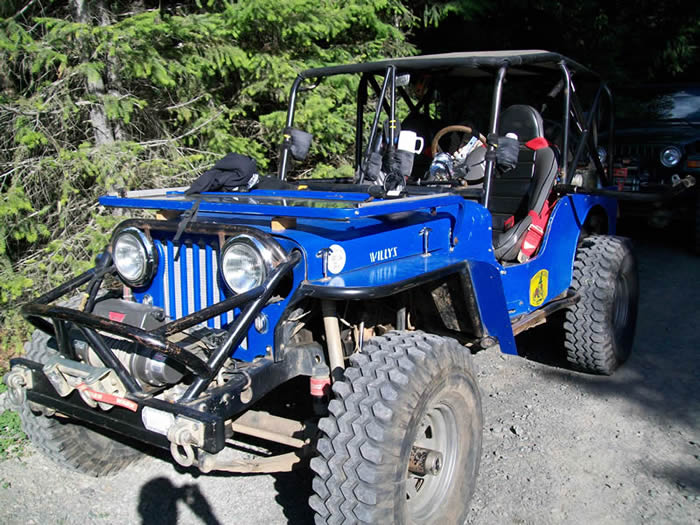
Marty, a fabricator, laser and plasma burn machine operator, sees the Alaska venture as a unique opportunity to partake in a once-in-a-lifetime jeeping event. He’ll be driving his specially built 1946 CJ-2A, a highly modified jeep that began as a bare frame and an old race jeep body. Desiring a family friendly vehicle that would take his family to ice cream, survive jeeping on tight rocky trails, and race on weekends, he spent two years constructing it. He stretched the jeep eight inches, while keeping the basic shape of the standard 4×4, added a roll cage (to protect his precious cargo), and updated the drivetrain and brakes to navigate the highways around Portland.

To facilitate weekends in the mountains, Marty added an ARB refrigerator to keep drinks cold, installed a winch to get him out of tough spots, and added an onboard compressor to pump up the tires after jeeping so he could drive it home after a long trip. A 327 Chevorlet engine powers everything, while a TH350 automatic transmission makes driving easier. Custom springs give the jeep a soft, firm ride. He even redrilled the bolt pattern on his transmission to transfer case adapter and rotated it counter clockwise a few degrees to improve his clearance. It’s a great performing jeep that will take him anywhere in Washington. Now, it will take him to Alaska for the first time.
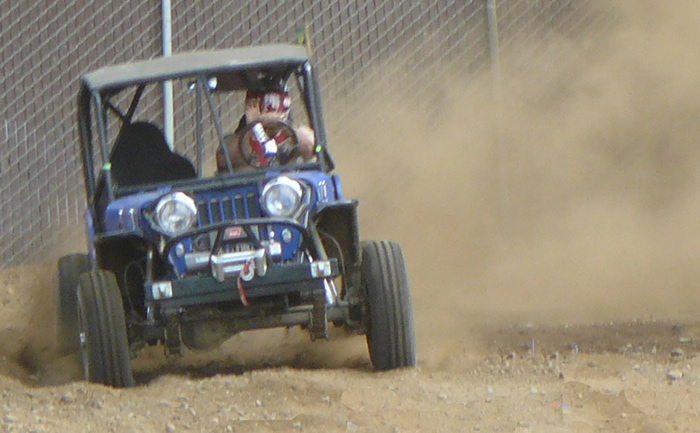
A Brief History of Four Wheel Drive Clubs & Associations:
When Willys-Overland released the world’s first civilian jeep, the CJ-2A in July of 1945, the company marketed it as a farm, ranch, utility, and get-a-person-to-a-remote-spot vehicle (for fishing or hunting). It was the purposeful, yet flexible nature of the vehicle that Willys hoped would drive sales. Perhaps it was management’s Midwest roots (farming, ranching and outdoors) that led to that sales strategy, but for whatever reasons, the jeep wasn’t positioned as a vehicle designed for recreation—as in the act of driving-the-vehicle-itself as a form of fun.
One demographic that embraced the fun and explorative nature of the CJ was west coasters from Washington to California. In 1946 there were still vast remote areas of the West never explored by vehicles and a wide range of climates and topography—ocean beaches, sands, deserts, hills, mountains, and forests ranging from sea level to 14,000 feet—that were perfect for exploring with the new civilian jeep. But, navigating these far-away areas solo could prove fool hardy, so groups of friends, then clubs of jeepers soon formed.
One of the first organized jeep clubs was, according to Four Wheeler Magazine, Sareea Al Jamel (Fast Camel), which formed in 1946. The next known club formed more than a thousand miles north, in tiny Yakima, Washington. In January of 1947 a group of jeep owners met and incorporated the world’s first jeep club, the Yakima Ridge Runners.
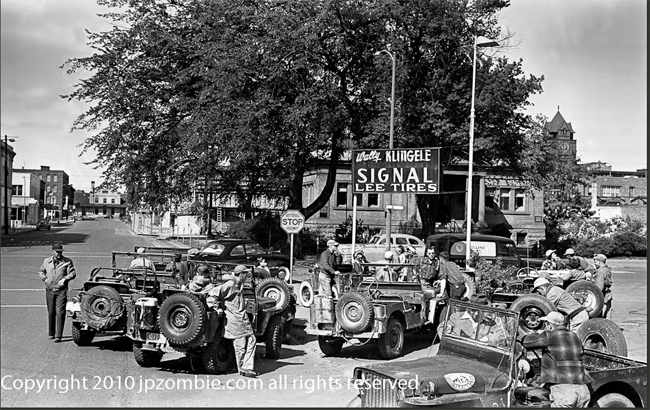
These and other early clubs led to two forms of recreation that Willys Overland did not seem to anticipate, jeeping and racing. California clubs like Sareea Al Jamel and the Hemet Jeep (formed in 1948 as the Hemet Cavalcade) explored the mountains, deserts, and beaches of southern California in groups. Meanwhile, the Yakima Ridge Runners were exploring their local Cascade Mountain Range, using a long abandoned wagon trail called the Naches.
For some of the Ridge Runner members, exploring the foothills of the Cascades wasn’t enough. Their competitive spirit, and likely some arguments over who had the faster jeep, led to head-to-head racing at a Native American site close to Yakima called the Jeep Bowl. It’s here the earliest documented jeep racing began in the United States. The Ridgerunner club’s activities eventually drew the attention of Life Magazine, which did an article on club members, and Universal News, which published two news reels of their antics.
In 1953, the town of Georgetown, hoping to stimulate tourism, hosted a jeep trek over an old stagecoach route called the Rubicon Trail. This marked the beginning of the famous Jeepers Jamboree. Events like this encouraged more people to purchase jeeps, which led to more interest in jeeping and racing. Slowly, the number of clubs grew, both along the west coast and throughout the country.
For multiple reasons—organization of activities, land use issues, and camaraderie—clubs began grouping together into associations. The California Association of Four Wheel Drive Association formed in 1959 and the Pacific Northwest Four Wheel Drive Association (Washington, Oregon, and Idaho) incorporated in 1960.
The formation of clubs and associations, and as part of both the recreative use of the jeep and the growing car culture, there were a flurry of jeep-related products that flourished. In the East and Midwest this came in the form of utilitarian items like snow plows, hardtops, farm equipment, and utility equipment (towing, generators, fire jeeps). A little later, in the 1950s and 1960s, start-ups began t produce recreative and performance products. These included jeeping enhancements (free wheeling hubs, winches, and carriers), drivetrain improvements for faster speeds (overdrives), and products for racing (fiberglass bodies, roll bars, racing seats, drivetrain modifications). Based on the types of older jeeps that have sold over the last ten years, these type of improvements proved more popular in the west than the east.
It was not uncommon in the Pacific Northwest for jeep owners in the 1960s and 1970s to use their jeeps for race, street, and trail. This led to safety modifications (brakes, roll cages, full harnesses), the installation of heavier duty parts (to survive racing and hard jeeping), practical driving improvements (better brakes lights and the swap to modern steering columns for turn signals), and a need for more power, in the form of V6 and V8s installations.
Today there are still jeep clubs all around the US (and around the world), though they are more often known as 4×4 clubs, due to their willingness to accept non-jeeps among their ranks. Club members volunteer annually to clean beaches, maintain trails, and help their communities. These days, their greatest challenge is less about surviving remote areas and more about keeping access to those areas open. With more people entering forests on foot, bike, motorcycle, atv, jeep, and truck, the danger to wild terrain isn’t the danger unto the people; it is the danger of permanently damaging the wilds they love so much. Tread lightly is now their common goal.
Rob Stafford and His 1948 CJ-2A
Rob Stafford is from Spanaway, WA and basically grew up in the back seat of the family’s 1963 CJ3B which currently lives in his garage in pieces and parts. In 1978 he purchased his first vehicle at the age of 15, a 1948 CJ2A. He has owned this vehicle ever since and will be driving it on this adventure with his friend Ron (on the way up) and his wife Diane (on the return journey).
The flatty is powered by a 1967 225 Buick odd-fire V6 and Ford top loader 3 speed, large shaft 18 transfer case, Warn overdrive, 30 front end and Herm the Overdrive Guy full floater axle kit fitted 44 rear end. Many of the non-stock modifications were created and added in the early 80’s in Rob’s high school shop classes.
Rob has spent most of his life in and around the 4 wheel drive community. He is a long time member of the Pacific Northwest 4 Wheel Drive Association and has served on the board of directors for the association as both the competition chairman and safety education director. Rob and his wife Diana belong to 3 Jeep clubs, the Cascade 4x4s of Tacoma, Countyline Offroaders, and Overbored Racing.
Although the CJ2A is his first love, he does have a mistress that offers a few more creature comforts. Most of the time nowadays he usually explores the trails around the beautiful Pacific Northwest in his 1998 TJ powered by a healthy all aluminum LS1, 700R4 transmission, highly modified 231 transfer case, custom built 44 front end, and disc brake 8.8 rear end, both fitted with 4:88s and ARB’s, and a cushy Rubicon Express Long Arm suspension.
When the need for speed hits, Rob and his wife Diana, take their 1946 custom built race Jeep to the track for a shot of adrenaline. It runs a 560 horsepower 327 and Ford top loader 4 speed, all wrapped in a fiberglass shell.
He has several other Willys projects scattered around in various states of restoration and modification. To fund his hobbies, Rob has spent the past 35 years working as an automotive repair technician and specializes in high end European cars.
A SHORT HISTORY OF JEEP RACING:
Unlike the history of jeep clubs, the history of amateur and semi-professional jeep racing is harder to trace. One of the earliest racing events was organized in Yakima, Washington, during the 1950s.
Racing spread quickly. Marque events were held in the later 1950s with the Jeep-O-Rama in Denver, Colorado, and the Jeep Derby in Truth Or Consequences, New Mexico. In the latter event, specially built passenger bars were used by (crazy) passengers to balance the jeep during difficult turns as demonstrated below:
Through the 1960s and into the 1970s, four wheel drive racing became very popular and spanned the nation. Racing circuits flourished on the Eastern Seaboard, in the Midwest, in the Mountain West, into Canada, and all along the West Coast. Race organizers adapted events to their terrain, such as swamp racing in the southeast and desert racing in the west.
Some racing was head on head, like drag, swamp, or wheel to wheel events, but others were timed events, like short track cross country racing and hill climbs. Still, other types of “racing” were more family oriented, such as potato races, backward courses, divorce courses (drivers drive blindfolded while the spouse directed them slowly through a course) and many other creative and fun ideas.
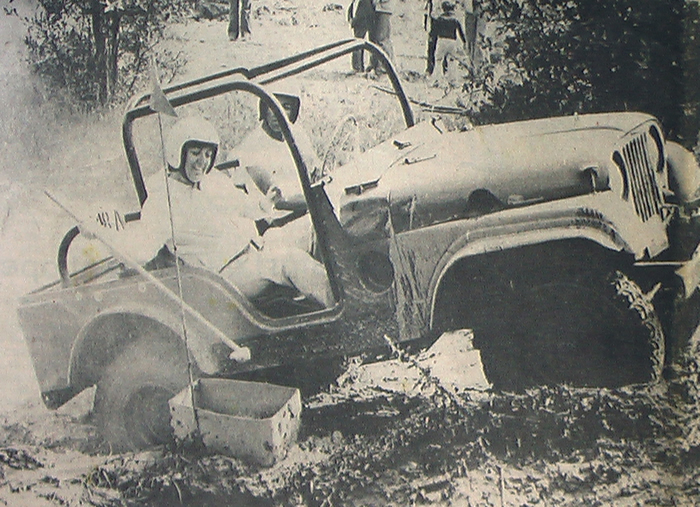
For complex social and economic reasons, amateur four wheel drive racing declined nationwide during the 1980s and into the 1990s. These days, the Pacific Northwest 4 Wheel Drive Association still holds events, but the massive crowds of old have given way to smaller events. Still, a great amount of fun is had. Below is a video filmed during 2016:
The Eastern 4 Wheel Drive Association continues to hold events as well, such as the Gravelrama show below:
In the Denver area, the Our Gang 4 Wheelers holds ice racing events during the winter, when ice permits.
Jim Fowler and His 1947 CJ-2A
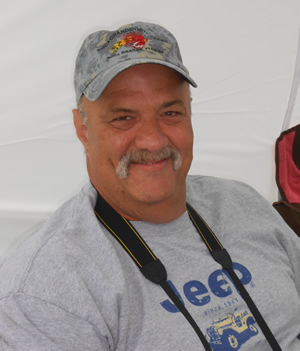
Jim Fowler will be traveling to Alaska with his friend Kevin in Jim’s 1947 CJ-2A towing a specially built trailer.
Before Jim went off to college in 1980, his father bought him a CJ-2A for $200. He couldnt believe it at first, especially when his father brought it home. It was in poor shape and was a learning experience. Two years later, after bouts of sporadic building, he had it on the road. Soon, it became his primary transportation for years.
Over the years, he has updated his jeep. One major update was the installation of a 1980 231 V6 and upgrading the electrical system to 12 volts. Hes also added a winch, roll bar, overdrive, and other miscellaneous changes.
As with most vintage jeep owners, Jim owns more than one jeep. He has a 1950 panel delivery wagon that was his great aunts jeep that needs some restoration. He also has a 1972 Ford Bronco.
Jims 1947 before his rebuild:

After the rebuild:

TIMELINE OF WILLYS-OVERLAND/JEEP NAMES AND OWNERS:
From its inception as the Overland Automotive Company in 1903 to its purchase by Fiat in 1914, the company we once knew as Willys-Overland and now know as the Jeep Corporation has gone through several ownership changes, each with unique complexities. For example, Willys-Overland’s ownership during the late 1930s and through WWII involved several inter-related companies, as a 1946 Fortune article explains in detail. Because of the nuances involved with each transaction, the timeline below gives just a taste of the Jeep’s corporate history as it changed names and owners:
1903: Overland Automotive Company formed by Claude Cox.
1908: John North Willys buys the Overland Automotive Company.
1912: Willys renames the company Willys-Overland. By then it was the second largest automaker (behind Ford).
1917: John Willys forms the Willys Company, a holding company that owned several automotive companies, including Willys-Overland, Electric Auto-Lite, F.B. Stearns, Russell Motor Car, and New Process Gear.
1940: American Bantam & Willys Overland submit prototypes for military contract.
1941: Willys-Overland wins military contract, introduces the Willys MB.
1945: Willys-Overland introduces the first civilian jeep, the CJ-2A.
1946: Willys-Overland introduces, arguably, the first SUV with the ‘Jeep’ Station Wagon.
1953: Willys-Overland is bought by Kaiser-Frazer. The two companies form a new entity called Kaiser-Willys. Willys Motors is formed to handle domestic jeep manufacturing and sales. The Willys Export Company is formed to handle international sales.
1963: Willys Motors is renamed Kaiser Jeep.
1969: Kasier Jeep is sold by Kaiser-Willys to the American Motors Corporation (AMC). Kaiser-Jeep is renamed the Jeep Corporation.
1987: The Jeep Corporation’s parent company, AMC, is acquired by Chrysler.
1998: Chrysler and Daimler-Benz merge to form DaimlerChrysler AG.
2007: Chrysler is sold to a private group.
2009: Chrysler enters and exits bankruptcy.
2011: Fiat buys initial stake in Chrysler.
2014: Fiat acquires full control of Chrysler.
More on the history of Willys/Jeep:
Joe Beadenkopf & His 1953 CJ-3B
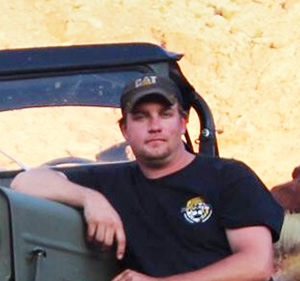 Joe Beadenkopf is a thirty-two year old master Auto Mechanic. He’ll be traveling to Alaska with his girlfriend, Emily Means.
Joe Beadenkopf is a thirty-two year old master Auto Mechanic. He’ll be traveling to Alaska with his girlfriend, Emily Means.
Growing up in a small town in Maryland, Joe lived in a neighborhood of muscle car builders. When he was fourteen, Joe helped a neighbor restore a 1970’s nova. That hooked him on old cars.
Joe was only eighteen when he bought his first jeep, a 1985 CJ-7. Once he caught the jeep bug, he couldn’t live without one. He’s not been without a jeep since.
On the Alaska Or Rust trip, Joe is taking his 1953 Willy CJ3B, a jeep he’s owned for 4 years. When he first bought it, the CJ-3B was nothing but a non-running rust bucket. It took years, but eventually Joe rebuilt it with a custom frame and upgraded suspension. He also swapped out the axles for a set of Dana 44s with front disc brakes. The jeep is powered by a fuel injected V6 with a five-speed manual transmission.
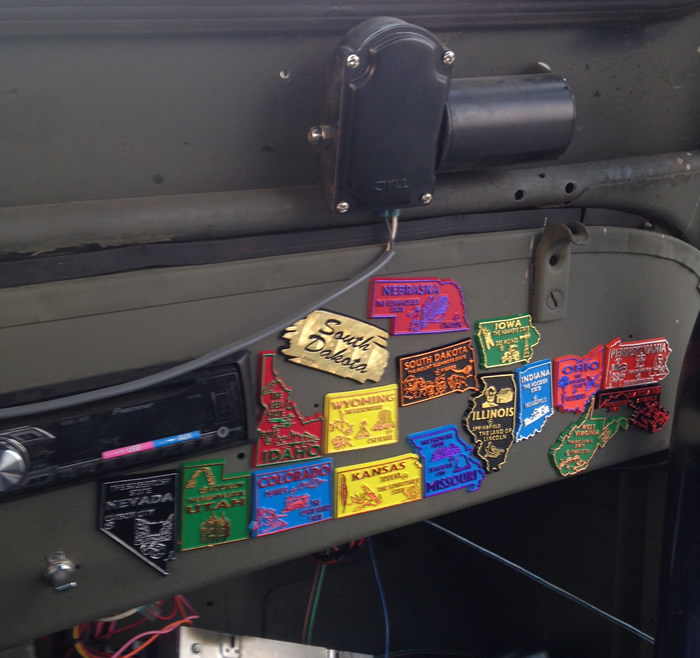
Joe is no amatuer when it comes to long road trips. In 2015, he drove his CJ-3B across the county. His friend from high school, Greg, joined him riding a Harley. Together they traveled almost 8,000 miles in two weeks. Joe’s goal is to drive his CJ-3B on as many adventures that he can. He can’t wait to hit the road with the East Coast Group and make memories that will last a lifetime.
CJ-3B HISTORY: The CJ-3B was first produced in 1953 as a transitional model between the low-powered WWII and earl civilian jeeps and the later CJ-5. The biggest visual difference between the early civilian jeeps and the CJ-3B was the taller hood and cowl, something Willys Overland engineers raised so they could install the taller f-134 four cylinder engine. This gave the CJ-3B a different look than its predecessors. Here is a comparison between a CJ-2A and a CJ-3B:
The CJ-3B was produced in the United States between 1953 and 1968, with production numbers totaling approximately 150,000 jeeps. The design was licensed aboard as well, where even more jeeps were manufactured.
There is no better source for the extensive history of the CJ-3B than the CJ-3B page: https://cj3b.info.







